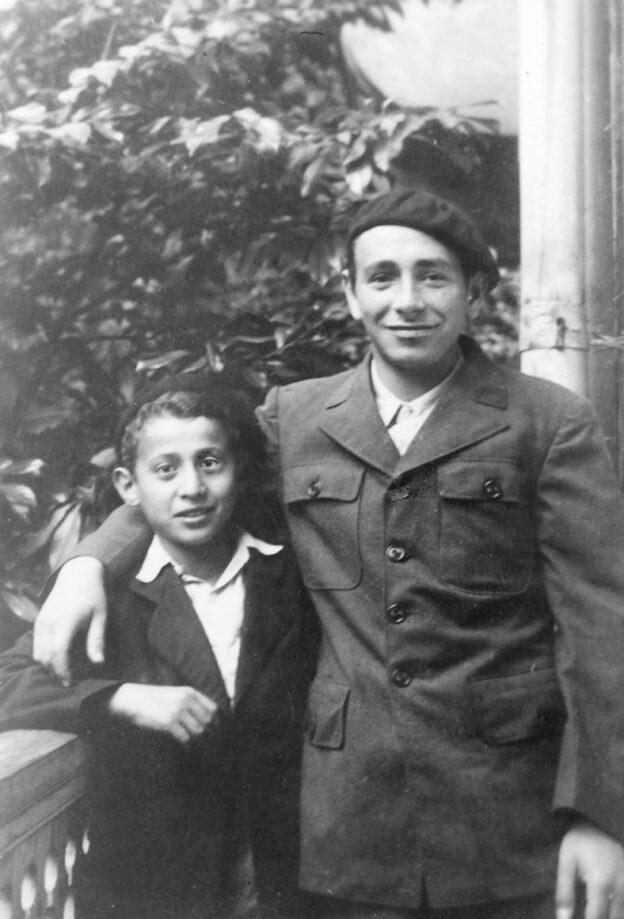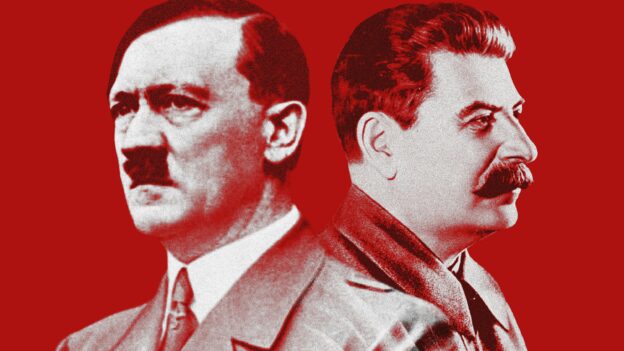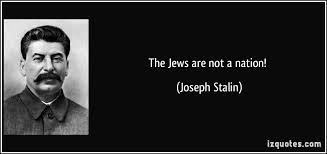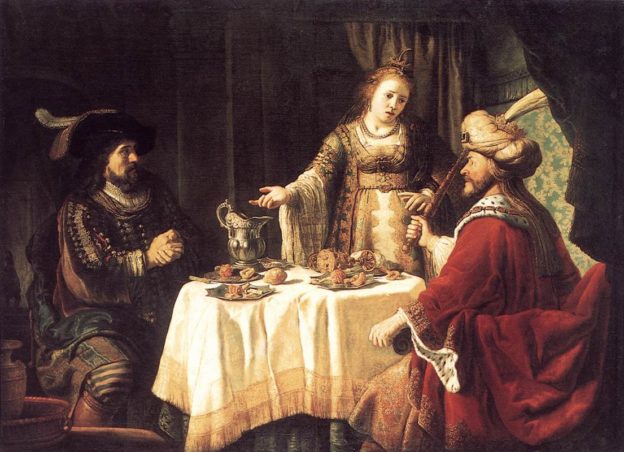There wasn’t a need to compose a Purim satire when the news provided enough to stimulate giggles. As you can read here:
Category Archives: PURIM
Parshas Shemos – Best-Laid Plans

The account of Moshe’s being placed in the river, discovered by bas Par’oh and raised in royal surroundings would seem to be of no import regarding the main narrative of Shemos – Moshe’s killing the Mitzri, fleeing as a result to Midian and being charged by Hashem with his mission.
Ibn Ezra, though, suggests that it is very much part of the larger story. He writes that “Perhaps Hashem arranged things so that Moshe would grow up in a royal house and his spirit would thereby be exalted” and he would “not possess a base spirit used to being in the house of slaves.”
That, he continues, was necessary for Moshe to be able to kill the Mitzri and intercede to help Yisro’s daughters (and, I might also suggest, to be able to receive nevu’ah, which requires a state of contentment).
Which makes for a delicious irony: Par’oh’s decree to kill baby boys is what required baby Moshe to be placed in the river, which resulted in his being raised as a royal, which allowed him to become the agent of Klal Yisrael’s geulah, the very thing Par’oh had sought to undermine.
“Many thoughts are in a man’s heart, but it is Hashem’s plan that will persevere” (Mishlei 19:21). It has been said that the intent of that pasuk is that those very thoughts of man can be the vehicle for the fruition of Hashem’s plan.
We see that not only in Par’oh’s ultimately self-undermining decree but in the narrative that ended Sefer Beraishis. As Yosef reassured his brothers about their plotting against him, which resulted in his elevation in Mitzrayim and his becoming the provider of food to the the nation and his family: “Indeed, you intended evil against me, [but] Hashem designed it for good, in order to bring about what is at present to keep a great populace alive.”
We read these parshios after Chanukah, on the path to the next Jewish holiday, Purim. There couldn’t be anything more Purim-centric than the irony of how best-laid plans can themselves bring about the opposite of the plotters’s wish: “Hashem’s plan.”
© 2023 Rabbi Avi Shafran

Joys and ironies of Purim echo through history

A Tale of Two Monsters
“Existence is by chance and thus meaningless” is Amalek’s credo.
Not only is the opposite true, but seeming “chance” “coincidences” are part of Amalek’s downfall.
To read about two not-so-long-ago examples of evil’s ends, please see:
https://www.amimagazine.org/2022/03/09/a-tale-of-two-monsters/

Parshas Yisro – The Barrel’s Secret
Our ancestors’ acceptance of the Torah was imperfect: It included an element of coercion.
The Gemara (Shabbos 88a) teaches that “Hashem held the mountain over the Jews’ heads like a gigis (a barrel).” The Maharal explains that the stunning nature of the experience, the terrifying interaction of human and Divine, left no opportunity for full free will. Directly interacting with Hashem, how could one possibly say no?
And that “coercion” remained a moda’ah, a “remonstration,” against Klal Yisrael, the Gemara teaches, until… the events commemorated by Purim.
In the time of Esther, the Jews chose, entirely of their own volition, to perceive Hashem’s presence where — diametric to the Sinai experience — it was anything but obvious. Instead of seeing the threat against them in mundane terms, Persia’s Jews recognized it as Hashem’s message, and responded with prayer, fasting, and repentance. And so, by freely choosing to perceive Hashem’s hand, they supplied what was missing at Sinai, confirming that the Jewish acceptance of the Torah was — and is — wholehearted and sincere.
The Gemara’s image of Hashem “holding the mountain over their heads” at Sinai is a striking metaphor. But why “like a barrel”? Isn’t a mountain overhead compelling enough? Who ordered the barrel?
One of the ways a person’s true nature is revealed is “b’koso” – “in his cup” – in his behavior when his inhibitions are diluted by drink. (Eruvin, 65b).
On Purim, in striking contrast to the rest of the Jewish year, we are enjoined to drink wine to excess. And what emerges from that observance, at least among Jews who approach the mitzvah properly, is not what we usually associate with inebriation, but rather a holy, if uninhibited, mode of mind.
Thus the revelation of our true nature provided by the Purim-mitzvah perfectly parallels the revelation of the Jews’ wholehearted acceptance of Hashem that took place at the time of the Purim events. With our masks (another Purim motif, of course) removed, we show our true selves.
In Pirkei Avos (4:20), Rabbi Yehudah HaNasi teaches us not “to look at the container, but at what it holds.”
A gigis, throughout the Talmud, contains an intoxicating beverage.
Hashem doesn’t look at the container — the coercion symbolized by the barrel held over our ancestors’ heads — but rather at how Jews act when they have imbibed its contents. He sees not our ancestors’ lack of full free will at the Sinai experience but the deeper truth about the Jewish essence, the one revealed by Purim’s wine.
© 2021 Rabbi Avi Shafran

My Purim’s Highlight
My Purim’s highlight was an interaction I had with two little boys, no older than 8 or 9. The shul I attend is often visited by a number of “collectors” asking for small donations, usually for the poor or needy institutions. Usually they are adults, with documentation backing the legitimacy of their quest for donations.
Sometimes, children approach people on behalf of their yeshivos or other charitable causes. On Purim, such undersized collectors abound. I must have been approached by little people 20 or 25 times. When my stash of dollar bills was down to one, wouldn’t you know, two youngsters approached me at the same time.
I smiled and showed them my last bill, identifying it as such. One boy, whose hand held more revenue that the other boy’s, unhesitatingly pointed to the other and said “Please give him.”
Which I did.
But the boy who directed me to the other one gave me something priceless, the story I just shared.

Anti-Semitic Conspiracy Theorists Don’t Stop at Hate Speech
Modern times, intriguingly, provide examples of would-be destroyers of Jews who met their fates in serendipitous, Purim-like ways. An essay of mine about that fact is in Haaretz today, here.
A freilechen Purim!

The Evidence in the Barrel
Back in a previous lifetime, when I was a mesivta rebbe, I once heard a menahel exhort our talmidim to not get carried away on Purim. As an illustration, he described how a certain Gadol on Purim simply went into his backyard and swung back and forth on a children’s swing. The implication was that the Gadol hadn’t imbibed much. I wasn’t so sure, myself. Ad d’lo yoda can express itself in different ways.
One thing is certain. Kedoshim u’tehorim on Purim, unleashed from the constraints of full daas, are more often seen singing and dancing spiritedly, even wildly, sharing divrei Torah and divrei sod that one might not ever hear from them the rest of the year.
Needless to say, and unfortunately, some who are less kadosh or tahor can overindulge on Purim and come to act very differently. They may imbibe stronger things than wine (the preferred mitzvah) in excess, even to the degree of actually endangering themselves. That is nothing short of a horrific Purim mask, an aveirah in the guise of a mitzvah.
But when the mitzvah is done right, though, even if the results are something more… well, dynamic than a placid visit to a backyard swing, something important about Klal Yisrael can be revealed. After all, Rabi Iloi (Eruvin 65b) tells us that one way a person’s essence can be discerned is “in his cup,” in his behavior when inebriated.
Something so important, in fact, that I once witnessed a Purim celebration causing an Italian cook at a yeshivah where I once taught to investigate geirus. By her admission, she told me that, over the years, she “had seen many people very drunk, but never so many people so drunk – without any fighting.” All she saw was celebration, friendship, good humor and happiness, and that, she said, had impressed her beyond words. (She was nevertheless dissuaded from her geirus plan.)
Chazal teach us (Shabbos, 88a) that something was lacking at Mattan Torah, and the lack only remedied centuries later in the Persian Empire.
Rav Avdimi bar Chama bar Chassa tells us there that “Hashem held the mountain over the Jews’ heads like a gigis [a barrel]” to force them to accept the Torah. One approach to that statement is that it refers to the experience of being directly addressed by the Borei Olam. Receiving direct communication from Hashem was so overwhelming, so traumatic, so crushing – after all, it caused our ancestors’ souls to leave them, and brought them to beg Moshe to be the only one to directly receive the final eight dibros – that it simply left no other choice but to accept His mission.
Experiencing the Divine fully does not leave one with truly free will to say “no.”
Rabbah comments that the “coercion” remained a remonstration against Klal Yisrael, that it colored our acceptance of the Torah as less than willful – until the “days of Achashverosh.”
For it was then that the Jews chose, entirely of their own volition, to perceive Hashem’s presence where there was no “mountain” held over their heads, where it was not only not overwhelming but not even obvious. Our ancestors chose to see Divine Providence in seemingly mundane, if alarming, political happenings, took the events to heart as a message from Above, and responded with tefillah, taanis and teshuvah. Thus, kiymu mah shekiblu kvar, they “completed” Mattan Torah, supplied what had been missing. The nation truly perceived Hashem, not only in thunder and lightning but in words inscribed on parchment and in a signet ring removed from a royal hand.
Moving back to what is revealed when Yidden have a proper simchas Purim, I’ve often wondered about Rav Avdimi’s strange choice of imagery. “Holding the mountain over their heads like a barrel.” Wouldn’t a mountain looming above be galvanizing enough? What’s with the barrel?
A gigis, however, throughout the Gemara, is a container for an intoxicating beverage. Chazal’s description of the implement of coercion at Har Sinai, in other words, is a beer-barrel.
Rabi Meir in Pirkei Avos (4:20) admonishes us not “to look at the container, but at what it holds.” It wouldn’t seem outlandish to perceive some pertinence of that admonition to the gigis to which Har Sinai is compared. Or, in turn, to Purim, when wine allows the essence of Klal Yisrael, our truest nature, to be revealed.
Don’t dwell, Rabi Meir may be saying, on our compromised acceptance of Hashem at Har Sinai in a state of coercion, but rather at our wholehearted, free-willed embrace of Him in our states of mindless purity.
Irony Trumps Iron
A piece I wrote about Purim and a famous Nazi was published by the Forward today. It can be read here.

Masquerading As Feminism
On Purim, Jewish men, to varying degrees, imbibe strong drink, and Jewish women do their best to keep them safe and anchored in civilization. The holiday thus may not seem very female-centered. But it is.
Not just because its hero is a heroine and the holy book about the historical event it commemorates is named after her, but because Megillas Esther verily revolves around femininity.
The pliable, preposterous monarch we meet at the Megillah’s start is a poster child (or, perhaps better, poster adolescent) for male chauvinism. His 180-day drinking party, as the Talmud describes it, was a bacchanal of arrested-development “good ol’ boys” acting like louts, and entailed the debasement, and eventual execution, of his queen.
And the next action of the foolhardy king was to organize the antithesis of true respect for women: a beauty contest.
And Achashverosh, of course, ends up being manipulated by a woman, our reticent, modest heroine Esther, and led by her to dispatch the Jews’ mortal enemy, saving her people from his evil plans.
But there’s a good deal more here, too, although it’s a good deal more subtle. Mordechai, the Midrash teaches us, was miraculously able to physically nurse the baby Esther when she was orphaned. Thus the male hero of the Purim story is rendered, at least in a way, something of a heroine himself.
And the Talmud’s very exhortation that a man is to drink “ad d’lo yada,” – literally, “until he doesn’t know…” – can be seen as a subtle reference to another Talmudic statement, that “nashim da’atan kalos.” That aphorism, often mistranslated as “women’s minds are weak,” is more accurately rendered “women’s daas is light.” That is to say that the psychological entity called daas (the root of both the words yada and da’atan) is less sharply present in women than in men (while another entity, binah, is more present in women than in men). What each of those entities precisely refers to isn’t for here and now, or for the likes of me to try to fathom. But still and all, ad d’lo yada can be seen as implying some sort of “feminization” of the aspirant. So men who “successfully” achieve the spiritual goal of drinking on Purim might be said to have in some way connected with their inner female.
Surprising and sublime thoughts like those are lost, however, on many people, certainly those who imagine they are somehow taking a stand for womanhood by celebrating, of all people, Vashti.
Yes, Vashti. The villainess of the Purim story, who enslaved, beat and humiliated Jewish women, and forced them to do work for her on the Sabbath.
What seems to have endeared Vashti to some simpleminded opinionators is her refusal (although out of sheer vanity) to obey Achashverosh’s summons to appear at his bash. As one pundit put it: “Saving the Jewish people was important, but at the same time, [Esther’s] whole submissive, secretive way of being was the absolute archetype of 1950’s womanhood. It repelled me. I thought, ‘Hey, what’s wrong with Vashti? She had dignity. She had self-respect’.”
Well, she had self-regard, anyway. So did for that matter, Ilse Koch, the “Beast of Buchenwald,” who stood up to her accusers in a West German court. But never mind.
Another writer describes Vashti as “a brave woman who risked her life for her beliefs,” seeing the Megillah’s message as, “Women who are bold, direct, aggressive, and disobedient are not acceptable; the praiseworthy women are those who are unassuming, quietly persistent…” and laments “the still-pervasive influence of the Esther-behavior model.”
And yet another advocate, a Reform rabbi, presumably oblivious to why feet are stomped at parts of Megillah readings, wrote: “Why aren’t we insisting that our synagogue communities cheer and stomp their feet at the mention of Vashti’s name? She is a foremother in the best sense of the word – assertive, appropriate, courageous.”
Although it’s hardly the first time it has happened, it’s still sad to see a carefully preserved Jewish historical tradition sacrificed on the altar of a contemporary ism.
But something’s sadder here, a tragic sort of vinahapoch hu. In their blind capitulation to the contemporary notion of feminism, the sacrificers here not only mangle the Megillah and mistake a malevolent oppressor for a role model. They miss entirely the genuinely feminist message of the Book of Esther: that the true power of womanhood isn’t to be found in trappings of manhood like self-regard and obstinateness, but in the embrace of the quintessentially feminine traits of modesty, selflessness, faith and courage.
© 2014 Rabbi Avi Shafran